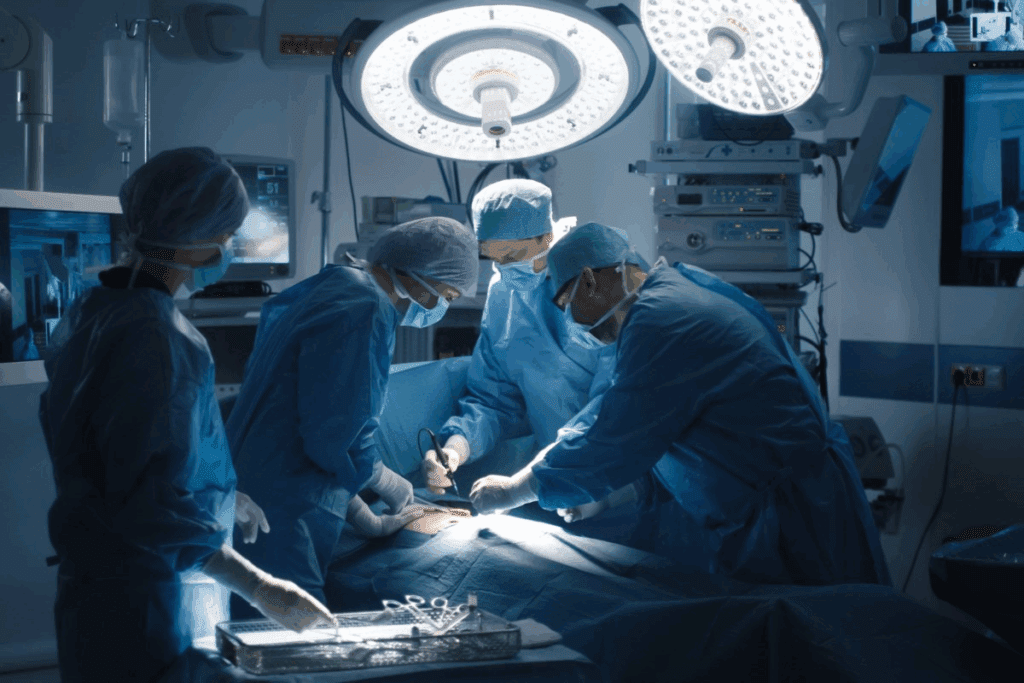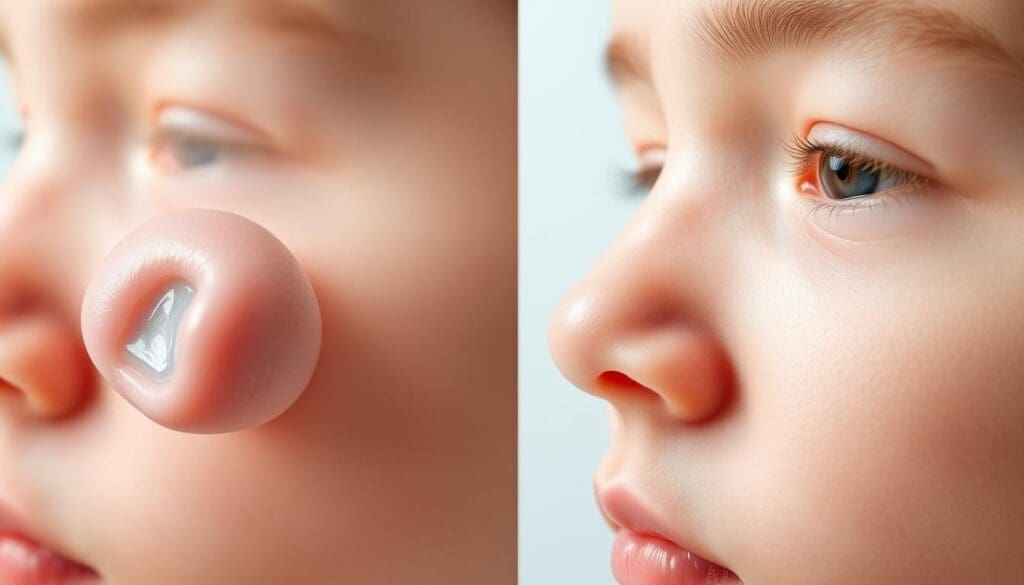Last Updated on November 20, 2025 by Hozen

An adenoidectomy is a surgery to remove adenoids. These are gland-like tissues at the back of the throat. It’s done to help with breathing problems and ear infections.
Big adenoids can lead to breathing issues and ear infections. This surgery is a common fix for these problems. It’s mainly done on kids.
The surgery happens under general anesthesia. The adenoids are taken out through the mouth. It’s quick and usually doesn’t hurt much. Most people recover fast.
Knowing about adenoids is key to staying healthy. Adenoids are tissues at the back of the throat that help fight off infections. When they get too big, it can lead to breathing problems, ear infections, and more.
If you’re having trouble breathing, your nose is always stuffy, or you keep getting ear infections, see a doctor. They can check if your adenoids are the issue and find the right treatment.
Adenoidectomy is a common surgery in otolaryngology, mainly for kids. It removes the adenoids. This surgery is often needed for kids with ear infections, breathing problems, and other issues due to big adenoids.
Research shows adenoidectomy is a common surgery, mostly for kids. It’s chosen when adenoids are too big, causing breathing issues or infections.
Adenoidectomy offers many benefits. It can ease nasal blockage, ear infections, and breathing troubles. This can greatly improve a child’s life and lower the risk of adenoid-related problems.
When done by skilled doctors, adenoidectomy is safe and works well. Knowing about its benefits helps families make better choices for their kids’ health.

Before your adenoidectomy, it’s key to know what to do. You’ll need a medical check-up and might have some tests. Your doctor will also give you important instructions.
It’s important to follow the pre-surgery rules. This might mean not eating before the surgery and making plans for aftercare. Knowing what to expect and following your doctor’s advice can help you recover well.
Modern adenoidectomy uses many surgical methods. Each has its own good points and things to think about. We’ll look at these methods closely, talking about their benefits and possible downsides.
The traditional curette method is one of the oldest ways to do adenoidectomy. It uses a curette to take out the adenoid tissue. This method works well, but it might cause more bleeding and take longer to heal than newer ways.
Key aspects of the traditional curette method include:

Endoscopic radiofrequency adenoidectomy is a more advanced method. It uses radiofrequency energy to remove adenoid tissue. This method is more precise and has less bleeding risk.
Benefits of endoscopic radiofrequency adenoidectomy include:
Coblation and microdebrider techniques are newer methods that are becoming more popular. Coblation uses controlled radiofrequency energy to remove tissue. Microdebrider techniques use a small, rotating blade to remove adenoid tissue precisely.
Advantages of coblation and microdebrider techniques:
The suction cautery approach combines suction and cautery to remove adenoid tissue and control bleeding. This method is great for reducing bleeding during the procedure.
Key benefits of the suction cautery approach:
In conclusion, there are many modern adenoidectomy techniques. Each has its own benefits and things to consider. The right technique depends on the patient’s condition, the surgeon’s skill, and the specific needs of the case.
Learning about the adenoidectomy process can ease worries for patients and their families. This surgery, though complex, is common for skilled surgeons.
The first step is giving anesthesia. General anesthesia makes sure the patient feels no pain. We tailor the anesthesia to each patient’s needs and health history.
With the patient under anesthesia, we start the surgery. We carefully position the patient for easy access to the adenoids. Special tools help us see the adenoids clearly, sometimes with an endoscope or mirror.
The main part of the surgery is taking out the adenoid tissue. We use different methods like curettage or coblation, based on the case. Our goal is to remove the tissue fully without harming nearby areas.
Next, we stop any bleeding. This is key to avoid complications after surgery. We use cautery or special agents to control bleeding. Once bleeding stops, the surgery ends, and the patient goes to the recovery room.
| Step | Description | Key Considerations |
| Anesthesia Administration | General anesthesia is administered to ensure patient comfort. | Patient’s medical history and specific needs are considered. |
| Surgical Access and Visualization | The patient is positioned for clear access, and instruments are used for visualization. | Clear visualization is critical for the procedure’s success. |
| Tissue Removal | Adenoid tissue is removed using techniques like curettage or coblation. | The choice of method depends on the case and surgeon’s preference. |
| Hemostasis and Completion | Bleeding is controlled using cautery or hemostatic agents. | Stopping bleeding is vital to prevent complications. |

Looking at before and after pictures of adenoidectomy helps us see its effects. Adenoids are tissues at the back of the throat. They can cause health problems if they get too big.
After surgery, people often feel much better. They get fewer infections and breathe easier. Removing adenoids can also help with nasal stuffiness, swallowing trouble, and ear infections.
It’s key for patients and their families to know what happens after surgery. This knowledge helps them make smart choices about their health.
After an adenoidectomy, it’s key to follow a care plan for a smooth recovery. This includes managing pain, watching for complications, and sticking to a healthy routine.
Pain meds are often given to help with discomfort after surgery. It’s important to take them as directed by your doctor to avoid problems.
It’s vital to watch for any signs of trouble like bleeding or infection. Know the signs and get help right away if you notice anything odd.
Eating soft foods for a few days helps with healing and comfort. Also, avoid hard work and get lots of rest to help your body recover.
By following these steps and your doctor’s advice, you can have a safe and easy recovery after adenoidectomy.
Let’s explore the recovery timeline and home care after an adenoidectomy. It’s key to follow certain steps for a smooth recovery. This ensures your child gets back to full health.
The first 24-48 hours are vital for your child’s recovery. They might feel some discomfort, like a sore throat and trouble swallowing. Keep them hydrated with water or Pedialyte.
Offer soft foods like yogurt, applesauce, and mashed potatoes. Watch their pain and give them pain meds as told by your doctor.
In the first week, your child will start to feel better. But, they should stick to a soft diet and avoid hard activities. Tell them to avoid heavy lifting, bending, or exercise for a week.
It’s also wise to keep them away from crowded places or sick people. This helps prevent infections.
The healing process can take several weeks. Most kids can go back to normal in 7-10 days. But, the adenoid area might take 2-3 weeks to fully heal.
Keep feeding them a balanced diet with soft, nutritious foods. Regular check-ups with your doctor are important to track their healing.
Diet is very important during recovery. Choose soft, easy-to-swallow foods that won’t irritate the throat. Some good options include:
Avoid spicy, acidic, or sharp foods to prevent discomfort or bleeding.
Adenoidectomy is a safe surgery to remove adenoids. But, like any surgery, it has risks and complications.
Complications can include bleeding, infection, and reactions to anesthesia. Knowing these risks helps manage expectations and aims for the best outcome.
Adenoidectomy has a high success rate. Most patients see a big improvement in their symptoms. The success depends on the surgeon’s skill and the patient’s health.
To lower the risk of complications, follow post-operative instructions closely. Watch for signs of infection, manage pain well, and go to follow-up appointments.
By understanding and managing risks, patients can have a successful adenoidectomy surgery.
Adult adenoidectomy is for those with ongoing adenoid problems. It removes the adenoid tissue. This can ease symptoms like nasal blockage, breathing trouble, and frequent infections.
After an adenoidectomy, adults might feel some pain. But, this can be managed with pain meds and rest. It’s important to follow the doctor’s post-op instructions to avoid complications.
Exploring adenoidectomy has shown it’s a key treatment for adenoid problems. We’ve covered the procedure, its advantages, and possible downsides. Our goal was to educate and inform you about this critical medical topic.
We hope our information has been useful and clear. If you’re thinking about adenoidectomy or have questions, we suggest getting professional advice. This will help you make the best decision for your health.
Adenoids are tissues at the back of the throat, near the nasal passages. They help the immune system, trapping bacteria and pathogens, mainly in young children.
Adenoids may need removal if they grow too big or get infected. This can cause ear infections, breathing issues, or sleep problems.
Adenoidectomy is a surgery to remove adenoids. It’s done under general anesthesia, through the mouth. The whole process takes about 30 minutes to an hour.
There are several ways to remove adenoids, like traditional curettage or endoscopic radiofrequency adenoidectomy. The method chosen depends on the surgeon and the patient’s needs.
Adenoidectomy can solve problems like ear infections, breathing issues, and sleep troubles. It also improves life quality, mainly for kids.
After surgery, you might feel pain, swelling, and discomfort in your throat. Rest, avoid hard activities, and eat soft foods for a few days.
Yes, like any surgery, adenoidectomy has risks like bleeding, infection, or anesthesia reactions. But these are rare.
Yes, adults can get adenoidectomy, though it’s more common in kids. The process is similar, but adults might need more time to recover.
Recovery time varies. Generally, it takes 1-2 weeks for the throat to heal. It can take several weeks to fully recover.
Adenoidectomy is very effective. Most patients see big improvements in symptoms and health after the surgery.
Sometimes, treatments like antibiotics or nasal corticosteroids are tried first. But adenoidectomy is often the best solution for enlarged or infected adenoids.
Explain the surgery to your child in simple terms. Address their fears and follow the surgeon’s pre-op care instructions.
Look for signs like frequent ear infections, breathing troubles, sleep issues, and constant nasal congestion or discharge.
Yes, adenoidectomy is often done with other surgeries like tonsillectomy. This can tackle multiple problems at once, reducing the need for more surgeries.
National Center for Biotechnology Information. (2025). How Are Adenoids Removed Procedure Recovery Guide. Retrieved from https://pmc.ncbi.nlm.nih.gov/articles/PMC7100808
Subscribe to our e-newsletter to stay informed about the latest innovations in the world of health and exclusive offers!